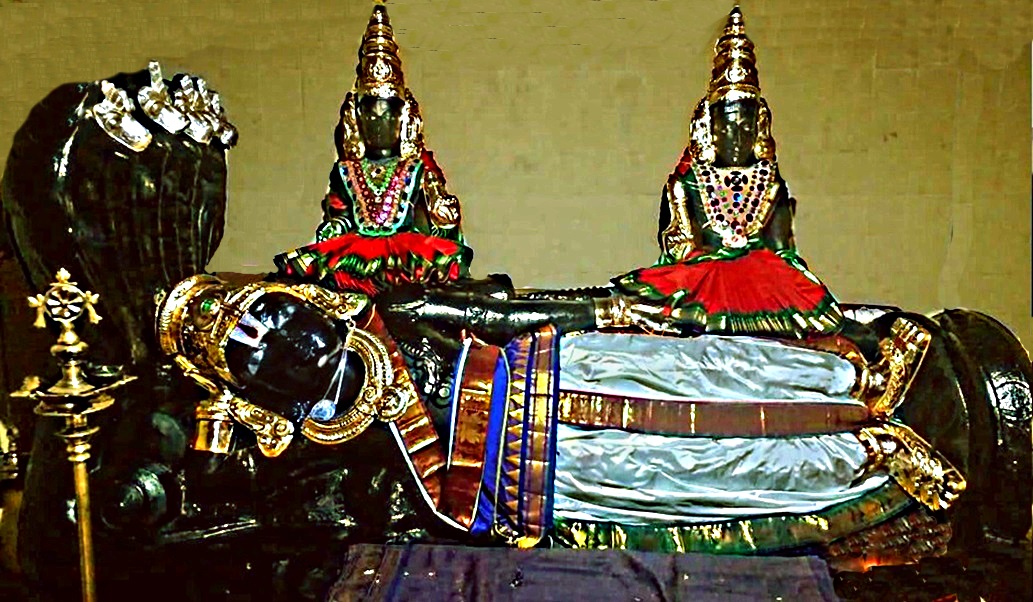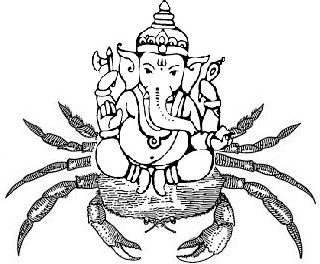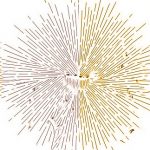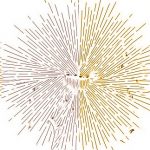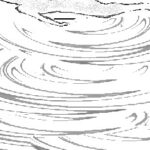சேங்காலிபுரம்
ஸ்ரீ தேவி பூதேவி சமேத
ஸ்ரீ பரிமள ரங்கநாதர்
ஆலயம்
-சாந்திப்பிரியா-
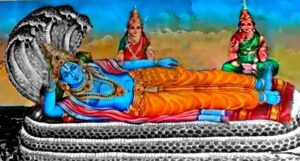
சேங்காலிபுரம் என்றாலே காலக்ஷேப சக்ரவர்த்தியாக இருந்த சேங்காலிபுரம் ஸ்ரீ அனந்தராம தீக்ஷிதர் பற்றியே அனைவருக்கும் நினைவு வரும். ஸ்ரீ அனந்தராம தீக்ஷிதர் தனது பிரசங்கள் மூலம் மஹாபாரதம், ராமாயணம் போன்றவற்றை பரப்பியதும், மகிஷாசுர மர்த்தினி ஸ்லோகங்களை பாடலாக பாடி பரப்பியதும் மக்கள் மனதில் இருந்து மறையாது. அவருடைய அண்ணன் பேரனான வித்தல்தாஸ் மஹராஜ் கோவிந்தபுரத்தில் பாண்டுரங்கருக்கு ஒரு ஆலயத்தையும் அமைத்து உள்ளார். அப்படிப்பட்ட பெருமை வாய்ந்த குடும்பங்கள் வாழ்ந்துள்ள ஊரே சேங்காலிபுரம் ஆகும். முன்னர் இந்த ஊரின் பெயர் திருக்கலீஸ்வரம் என்று இருந்தது. சாஸ்திரங்களிலும் இந்த ஊரை சிவகலிபுரம் எனக் குறிப்பிட்டு உள்ளார்கள். பதினொன்றாம் நூற்றாண்டில் ராஜேந்திர சோழ மன்னனின் படை தளபதியான அரவான் ராஜராஜன் என்பவர் சாளுக்கிய மன்னனான ஜெயசிம்மனை தோற்கடித்ததினால், இந்த ஊரை அவருக்கு பரிசாக மன்னன் கொடுத்து விட, இந்த ஊரின் பெயர் ஜயசிங்ஹ குலகாலபுரம் என ஆயிற்று. நாளடைவில் அதுவே மருவி சிங்காலபுரம் எனவும் சேங்காலிபுரம் என்றாயிற்றாம்.
கும்பகோணம் -திருவாரூர் செல்லும் வழியில் குடவாசல் எனும் ஊரின் அருகில் உள்ள இத்தனை பெருமை வாய்ந்த சேங்காலிபுரத்தில் பல புராதான, வரலாற்று சிறப்பு மிக்க ஆலயங்கள் உள்ளன என்ற செய்தி குறித்து பலருக்கும் தெரியவில்லை என்பது வியப்பாக உள்ளது. சேங்காலிபுரத்தில் மூன்று பெருமாள், நான்கு சிவன், ஒரு முருகன், இரண்டு பிள்ளையார், ஒரு மாரியம்மன், ஒரு பிடாரி ஆலயம் என சுமார் பதினெட்டு ஆலயங்கள் உள்ளன. அவற்றில் மிக பிரசித்தமானவை ஸ்ரீ தேவி பூதேவி சமேத ஸ்ரீ பரிமள ரங்கநாத ஸ்வாமி ஆலயமும், தத்தகுடீரம் எனும் ஸ்ரீ தத்தாத்திரேயர் ஆலயமும் ஆகும். ஸ்ரீ மஹாவிஷ்ணுவின் ஒரு அம்சத்தைக் கொண்டவர் ஸ்ரீ தத்தாத்திரேயர் ஆவார். ஆலயங்களைக் குறித்து சாதாரணமாக பழமையான சொல் ஒன்று உண்டு. ஒரு ஆலயத்துக்கு செல்ல வேண்டும் என்றால் அந்த ஆலயத்துக்கு செல்ல பிராப்தம் மட்டும் அல்ல அந்த ஆலய தெய்வம் விரும்பினால் மட்டுமே செல்ல முடியும் என்பதே அந்த பழமை சொல் ஆகும். அதனால்தான் ஒவ்வொரு யுகங்களிலும், இந்த ஊரிலேயே அவதரித்துள்ள, பல புராண வரலாறுகளை மையமாகக் கொண்ட, ஸ்வயம்புவாக எழுந்தருளி உள்ள பெருமாளை அவர் வீற்றுள்ள ஸ்ரீ தேவி பூதேவி சமேத ஸ்ரீ பரிமள ரங்கநாத ஸ்வாமி ஆலயத்தில் பிராப்தம் உள்ளவர்களால் மட்டுமே தரிசிக்க முடிகின்றது. இந்த ஊரில் ஒரு காலத்தில் வேத நெறிமுறையை தவறாமல் கடைபிடித்தபடி நிறைய அந்தணர்கள் வாழ்ந்திருந்தார்கள். அவர்களில் ஸ்ரீ முத்தண்ணாவாள் என்பவர் முக்கியமானவர். எவர் ஒருவர் அவரது சமாதிக்கு சென்று வணங்கி வருவார்களோ அவர்களுக்கு பலவிதமான நோய்கள் குணமாவதாகவும் வயிற்று வலி போன்ற ரோகங்கள் குணமாகி வந்ததாகவும் கூறுகின்றார்கள்.
சாதாரணமாக ஆலயங்களை ஐந்து வகையிலான ஆலயங்களாக பிரித்துக் கூறுவார்கள். அவற்றை ஸ்வயம் வியக்தம், தைவிகம் , ஆர்ஷம், மானுஷம், மற்றும் பௌராணம் என்ற ஐந்து பெயர்களில் அழைக்கின்றார்கள். இறைவன் தானாகவே விக்கிரக வடிவில் ஓர் இடத்தில் தோன்றினால், அந்த ஆலயங்களை ஸ்வயம் வியக்த க்ஷேத்திரம் என்று சொல்வார்கள். வியக்தம் என்றால் வெளிப்படுதல் என்று பொருள். ஸ்வயம் வியக்தம் என்றால் இறைவன் சுயமாகவே வெளிப்பட்ட திருத்தலம், அதாவது தானாகவே அவதரித்த தலம் என்பார்கள். முனிவர்கள், ரிஷிகளால் பிரதிஷ்டை செய்யப்பட்ட கோவில்களை ஆர்ஷம் என்று சொல்கிறோம். தைவிகம் என்றால் தேவர்களால் அமைக்கப்பட்ட மற்றும் தேவர்கள் முதல் பல துணை, இணை தெய்வங்களாலும் வழிபடப்பட்ட விக்ரஹங்களை ஸ்தாபனம் செய்து வழிபடும் ஆலயம் என்பார்கள். அரசர்கள், பக்தர்கள் உள்ளிட்ட மனிதர்களால் பிரதிஷ்டை செய்யப்பட்ட திருத்தலங்கள் மானுஷம் என்றழைக்கப்படும். பௌராணம் எனும் ஆலயங்கள் புராண வரலாற்றில் பெருமையாக கூறப்பட்டுள்ள ஆலயங்கள் ஆகும்.
பொதுவாகவே ஸ்வயம் வியக்தம் மற்றும் தைவிகம் எனப்படும் ஆலயங்களில் செல்லும் பக்தர்கள் அவற்றில் உள்ள தெய்வீக சக்தியின் ஆற்றலை, அதிர்வலைகளை நன்றாகவே உணர முடியும். அதே சமயத்தில் அந்த ஆலயங்களுக்கு அனைவராலும் செய்ய முடியாது. ஒருவருக்கு பிராப்தம் இருந்தால் மட்டுமே அப்படிப்பட்ட ஆலயங்களுக்கு செல்ல இயலும் என்பதாக ஆன்மீக மஹான்கள் கூறுவார்கள். அதை போலவே ஸ்வயம் வியக்தம் எனப்படும் ஆலயங்களில் செய்யப்படும் பூஜைகள் மற்றும் ஆராதனைகளின் பலன்களும் பதினான்கு உலகங்களுக்கும் நன்மைகளை தந்து அங்குள்ள மக்களைக் காப்பற்றுமாம்.
சேங்காலிபுரத்தின் முன் கால பெயர் ஸ்வயம் கலிகரபுரம் மற்றும் புல்லாகவனம் என்று கூட இருந்தது. இந்த தலத்தில் பல முனிவர்களும், ரிஷிகளும் மகான்களும், தவம் இருந்து பெருமாளின் அனுகிரகத்தை அடைந்துள்ளார்கள். கலிஹரபுரம் என்றால் கலியின் தோஷங்களை விலக்க பெருமாள் அவதரித்த தலம் என்பதாகும். இதனால்தான் தானாகவே இங்கு அவதரித்த பெருமாளை ஸ்வயம்கலிஹரர் என்று அழைத்து வந்துள்ளார்கள். அதை போலவேதான் புல்லாகவனம் என்றால் பல்வேறு கால்நடைகள் அமைதியாக வாழ்ந்து கொண்டிருந்த அடர்ந்த வனப்பகுதி என்பதாகும். இங்குள்ள ஸ்ரீ பரிமள ரங்கநாதர் ஆலயத்தின் கிழக்கு பக்கத்தில் உள்ளது ஒரு சிவன் ஆலயம். அதன் பெயர் சிவகங்காதீரம் என்பதாகும். அங்கு நிஸ்துலா அம்பிகா சமேத சூளேஸ்வரர் எனும் பெயரில் சிவபெருமான் அருள் பாலித்துக் கொண்டு உள்ளார். இதே ஊரின் நேர் பின்புறத்தில் உள்ள ஆலயத்தில் ப்ரஹன்நாயகி சமேத துந்துபிஸ்வரர் அருள் புரிந்து கொண்டு உள்ளார். மற்றும் ஆலயத்தின் வலது பக்கத்தில் மும்மூர்த்திகளின் அவதாரமான ஸ்ரீ தத்தாத்திரேயர் ஆலயமும் அமைந்து உள்ளது. இப்படியாக இந்த மூன்று ஆலயங்களால் சூழ்ந்துள்ள இந்த ஆலயம் பெருமை பெற்ற தலமாக உள்ளது.
சேங்காலிபுரத்தில் உள்ள பரிமள ரங்கநாதர் ஆலயம் ஸ்வயம் விக்தத்கில் அடங்கும் ஆலயம் ஆகும். கலி தோஷங்களை விலக்க பெருமாள் பக்தர்களின் குறைகளை நீக்க, தானாகவே இங்கு எழுந்தருளி, சயனக் கோலத்தில், ஸ்ரீ தேவி பூதேவி சமேதராக காட்சி தந்தபடி, ஸ்வயம் கலிகலிஹரர் எனும் பெயரில் அருள் புரிந்து கொண்டு உள்ளார். பொதுவாக அனைத்து ஆலயங்களிலும் சயன கோலத்தில் காணப்படும் பெருமாள் ஆகாயத்தை நோக்கி படுத்த நிலையில் காணப்படுவார் . ஆனால் இங்குள்ள பெருமாளோ சயன கோலத்தில் இருந்தாலும், தனது முகம் உட்பட முழு சரீரத்தையும் பக்தர்களுக்கு கட்டி அருள் பாலிக்கும் வகையில் சயன கோலத்தில் காட்சி தருகின்றார் என்பது ஒரு அதிசய காட்சியாகும். தனது ஒரு கைமீது தலையை வைத்து படுத்தபடி சயன கோலத்தில் உள்ளார். பூமி மீது நேரடியாக தலையை வைத்துக் கொண்டு படுக்கலாகாது என்பது ஒரு நெறிமுறை என்பதினால், அதை தவிர்க்கவே தனது ஒரு கையின் மீது தலையை வைத்துக் கொண்டு படுத்து உள்ளார் என்பதாக இதற்கான விளக்கம் தரப்படுகின்றது.
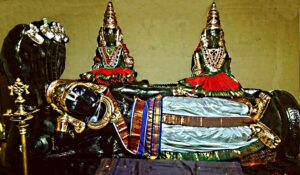
இந்த ஆலயத்தின் மேன்மைக் குறித்த சில கதைகள் உள்ளன. புதுக் சக்கரவர்த்தி என்ற ஒரு மன்னன் தனக்கு தெய்வீகமான ஞானம் வேண்டும், அதாவது தெய்வங்களை பற்றிய அனைத்து உண்மைகளையும் அறிந்து கொள்ள வேண்டும் என்ற ஆவலில் இங்கு வந்து தவம் இருந்தபோது, பெருமாள் இங்கு ஸ்வயமாக அவதரித்து அவருக்கும் காட்சி தந்து, அவர் கேட்ட ஞானத்தையும் தந்தருளியதான வாய் மொழிக் கதை உள்ளது. அந்த மன்னன் பிற்காலத்தில் மரணத்தை அடையாமல் பெருமாளோடு ஐக்கியம் ஆகிவிட்டதாகவும் ஒரு கதை உள்ளது. அதை போலவே ஸ்ரீமன் ராமர் பிறப்பதற்கு பல காலத்துக்கு முன்பாகவே தசரத சக்ரவர்த்தி தனக்கு ஒரு குழந்தை வேண்டும் என்பதற்காக பல ஆலயங்களிலும் யாகங்கள், பூஜைகள், பரிகாரங்கள் செய்தும் எந்த பலனும் கிடைக்காமல் போனதினால் தனக்குப் பிறகு தனது தேசத்தை பரிபாலனம் செய்ய எந்த பிள்ளையும் இல்லையே என மனம் ஒடிந்து போன நேரத்தில், மீண்டும் யாரோ ஒரு முனிவர் கொடுத்த அறிவுரையை ஏற்றுக் கொண்டு த்ரேதா யுகத்தில் இந்த ஷேத்திரத்துக்கு வந்து சுமார் ஒரு வருட காலம் தவத்தில் இருந்தார் . ஆனாலும் அவருக்கு பிள்ளை பிறக்கும் எந்த ஒரு அறிகுறியும் தெரியாமல் இருக்கவே அங்கிருந்து வருத்தத்துடன் திரும்பிப் போகையில், அவர் முன் தோன்றிய ஸ்ரீ தேவி மற்றும் பூதேவி ‘உனக்கு அனுக்கிரஹம் கிடைக்கும் வேளை வந்து விட்டதினால் இன்னமும் சற்றே இங்கிருந்து புத்திர பாக்கியம் கிடைக்க பெருமாளை தோத்திரம் செய்’ என அழைத்தார்கள். அந்த நிலையில் இங்கேயே இரு என கூறும் வகையில் காட்சி தரும் கைகளுடன் இரு தேவிகளும் காணப்படுகின்றார்கள். அந்த தேவிகளின் கைகளை உற்றுப் பார்த்தால் இந்த காட்சியைக் காணலாம். பிற ஆலயங்கள் அனைத்திலும் உள்ள இரு தேவிகளும் கைகளில் பூ அல்லது ஆயுதங்களோடு காட்சி தர இங்கு மட்டுமே ‘ இங்கு இன்னும் சற்று இரு’ என கூறுவது போன்ற நிலையில் உள்ள கைகளோடு காட்சி தருகிறார்கள். அதைக் கேட்டு படுத்திருந்த பெருமான் அங்கேயே நின்றிருந்த தசரதரை நோக்கி சற்றே ஒருக்களித்து படுத்துக் கொண்டு கூறினாராம் ‘ தசரதா, நான் உன்னுடைய தவத்தினால் மகிழ்ச்சி அடைகிறேன். ஆனாலும் இன்னமும் உனக்கு உள்ள பாவங்களை தொலைத்துக் கொள்ள சில புண்ணிய காரியங்களை செய்ய வேண்டி உள்ளது. அவற்றையும் நீ செய்து முடித்தப் பின்னர், நானே உனக்கு புத்திரனாக பிறப்பேன்’ என அருள் புரிந்தார். அதைக் கேட்டு மனம் மகிழ்ந்து போன தசரதன் ஊர் திரும்பி, தனது அரச சபையைக் கூட்டி தான் செய்துள்ள எதோ ஒரு பாவத்தினால்தான் தனக்கு இன்னமும் புத்திர பாக்கியம் கிடைக்கவில்லை என்பதை தான் தெரிந்து கொண்டதினால், அந்த பாபத்தைக் களைந்து கொள்ள, அரசர்கள் கடைபிடிக்கும் பாவப் பரிகாரமான அஸ்வமேத யாகத்தை செய்ய உள்ளதாகக் கூறி, அவருடைய குருவான வஷிஷ்டருடைய அறிவுரையையும் ஆசீர்வாதங்களையும் கேட்டாராம். உடனடியாக வசிஷ்டரும், அவருக்கு ஒன்றல்ல, இரண்டல்ல மாறாக நான்கு பிள்ளைகள் பிறக்கும் என தசரதனை ஆசிர்வதித்தப் பின்னர் சற்றே யோஜனை செய்து பார்த்தாராம் ‘சாதாரணமாக மன்னர்கள் அரச சபையைக் கூட்டி பாவப் பரிகாரத்திற்கு என்ன செய்யலாம் என ஆலோசனை கேட்பார்கள். ஆனால் அதற்கு மாறாக தசரதனோ பாவத்திற்கு பரிகாரமாக தான் செய்ய உள்ள பரிகாரத்தையும் அல்லவா கூறி உள்ளார் என்பதினால் அது அவர் எடுத்த முடிவாக இருக்காது. சேங்காலிபுரத்துக்கு சென்று தவம் புரிந்துள்ளதினால், அங்கு எழுந்தருளி உள்ள ஸ்ரீ ரங்கநாத பெருமானே அதை அவருக்கு கூறி இருக்க வேண்டும்’ என நினைத்தாராம். இப்படியாக அஸ்வமேத யாகத்தை செய்த தசரதனுக்கு நான்கு மகன்கள் பிறந்தனராம். இதன் மூலம் என்ன விளங்கியது என்றால் இராமாயண காலத்துக்கு முற்பட்ட காலத்திலேயே இந்த தலம் இருந்திருக்க வேண்டும். அங்கு பெருமாள் எதோ ஒரு ரூபத்தில் எழுந்தருளி இருந்தார் என்பதே. அதனால்தான் ராமனாக அவதரிக்க உள்ள காலத்தில், தான் கடைபிடிக்கும் தர்மத்திற்கேற்ப குணம் கொண்ட யாரை தந்தையாக அடைவது என நினைத்திருந்த பெருமாள், தசரதனை அங்கு வரவழைத்து, தானே அவருக்கு மகனாக பிறப்பதாக வாக்குறுதி தந்து அருள் புரிந்துள்ளார்.
அதை போலவேதான் தனது தந்தை பரீக்ஷித்து மரணம் அடைக்க காரணமாக இருந்த சர்ப இனத்தையே அழிக்க வேண்டும் என்ற எண்ணத்தினால் ஒரு யாகத்தை செய்து பல சர்பங்களை கொன்ற பாவத்தினால் ஜனமேஜயனுக்கு உடம்பெல்லாம் பாம்புத் தோல் உறைவதை போன்ற சரீர வியாதி வந்து விட்டது. அதற்கு எங்குமே நிவாரணம் கிடைக்காத நிலையில், துவாபர யுகத்தில் இந்த தலத்துக்கு வந்த ஜனமேஜயன், இங்குள்ள ஸ்ரீ ரங்கநாதரை வழிபட்டு நிவாரணம் பெற்றதாக வரலாற்று செய்திகள் வாய்மொழிக் கதையாக கூறப்பட்டு வருகின்றது.
அதை போலவே பெருமாளையே வணங்கித் துதித்த காரணத்தினால் தனது மகன் எனவும் பார்க்காமல் பிரகலாதனை ஹிம்சித்த அவரது தந்தையான ஹிரண்யகசிபுவை, தன்னை அறியாமலேயே தான் வணங்கிய பெருமாளையே நரசிம்ம அவதாரத்தை எடுக்க வைத்து கொன்ற பாவத்தினால் பிரஹலாதர் பித்ரு ஹத்தி அதாவது பித்ருவை கொன்ற தோஷத்தை அடைந்தார். அதை களைந்து கொள்ள பிரஹலாதர் பெருமாளை தஞ்சம் அடைய, அவரோ புல்லாகவனம் எனும் ஷேத்திரத்துக்கு சென்று, அங்கு தான் வரதராஜர் மற்றும் ரங்கநாதராக உள்ள ஆலய தீர்த்தத்தில் ஸ்நானம் செய்து, தன்னை அங்கே வழிபட்டு தோஷத்தை களைந்து கொள்ளுமாறு கூறினாராம். அந்த ஷேத்திரமே இப்போதுள்ள சேங்காலிபுரம் என்பதினால் இங்குள்ள ஸ்ரீ ரங்கநாத பெருமாள் எத்தனை யுகங்களாக இங்கு மீண்டும் மீண்டும் பல்வேறு ரூபங்களிலும் பெயர்களிலும் அவதரித்து உள்ளார் என்பது விளங்கும்.
இப்படியாக யுகம் யுகமாக அவதரித்து வந்த பெருமாள் ஆலயம் இங்கு அமைந்த வரலாறும் சுவையானது. சுமார் 500 அல்லது 6௦௦ ஆண்டுகளுக்கு முன்னால், இந்த ஊரில் இருந்தவர்கள், தற்போது இந்த ஆலயம் உள்ள இடத்தில் நடைபெற இருந்த ஒரு சுப காரியத்திற்கு கிளம்பிச் சென்று கொண்டு இருந்தபோது, வழியில் ஒரு பைத்தியம் வந்து அவர்களை அங்கு செல்லாமல் தடுத்து நிறுத்தி, அங்கு பெருமாள் புதைந்து உள்ளார், அங்கு பெருமாள் புதைந்து உள்ளார் என மீண்டும் மீண்டும் கத்தினார். அதைக் கேட்டு சுப காரியம் தடைபெறுகின்றதே எனக் கோபம் கொண்டவர்கள் அவர் கூறிய இடத்தை தோண்டிப் பார்ப்பதாகவும் , அப்படி அங்கு அந்த பைத்தியம் கூறியபடி பெருமாள் காணப்படவில்லை எனில் அந்த குழியிலே அவரை கொன்று புதைத்து விடுவோம் எனக் கூறிவிட்டு அந்த இடத்தை தோண்டினார்களாம். ஆனால் அன்று மாலைக்குள்ளேயே அங்கு புதைந்து இருந்த பெருமாள் தலைப் பகுதியை கண்டு அதிசயித்தார்களாம். மீண்டும் மறுநாள் வந்து தோண்டி பார்க்கலாம் என வீடுகளுக்கு சென்று விட்டார்கள். அன்று இரவே அவர்கள் அனைவரது கனவிலும் தோன்றிய பெருமாள், தன்னை எந்த கோலத்தில் பார்த்தார்களோ அதே கோலத்தில் அங்கேயே பிரதிஷ்டை செய்து, ஆலயம் அமைத்து வழிபட்டால் அவர்களை தாம் காப்பாற்றுவதாக அருள் மொழி கூற அவர்களும் மறுநாள் அதே இடத்துக்கு சென்று பூமியை தோண்டியபோது அங்கு புதைந்து இருந்த மொத்த சிலைகளும் கிடைத்தன. அங்கேயே தற்போது காணப்படும் ஆலயமும் எழுந்தது. ஆலயத்தில் உள்ள பெருமாளுடைய வலது காலில் ஆறு விரல்கள் உள்ளன. அதை தரிசிப்பவர்களுக்கு பெரும் அதிருஷ்டம் வரும் என்பது நம்பிக்கை ஆகும். நான்கு பக்கமும் சிவாலயம் உள்ள இந்த ஆலயத்தின் சன்னதியை சுற்றி ஏழு பிராகாரங்கள் இருந்துள்ளது என்கின்றார்கள். இவருக்கு பூர்வ ஜென்ம புண்ணியம் உள்ளதோ அவர்களால் மட்டுமே இந்த ஆலயத்திற்கு வந்து பெருமாளை தரிசிக்க முடியும் என்பதாக இங்குள்ள ஆலயத்தின் கூறுகின்றார்கள். அதனால்தான் இத்தனை மகிமை வாய்ந்த இந்த ஆலயத்தைக் குறித்து பலருக்கும் தெரிந்திருக்கவில்லை.
Sengalipuram
Sri Devi Bhoo Devi Samedha
Sri Parimala Ranganathar
Temple
-Santhipriya-

Ask anyone about Sengalipuram, they will remember only the name of Sengalipuram Sri Anantharama Dikshitar who was a great exponent of the art of upanyasas (discourses) on Ramayana, Mahabharata and also for the singing of Mahishasuramardini sthothram. His brother Narayana Dikshitar’s grandson is Shri Vitaldas Maharaj who is continuing this tradition and also instrumental in the construction of Govindapuram Panduranga Temple. It is a small village near Kudavasal in Kumbakonam – Thiruvarur route. The old name of this village was Thirukaleswaram. Its name has also been mentioned as Sivakalipuram in Shastras. In the 11th century, the commander of King Rajendra Chozhan, Arayan Rajaraja, defeated the Chalukya King Jayasimha. Due to this victory the king gifted this village to his commander and therefore it came to be called Jayasinga kulakalapuram. Later the name re-changed as Sengalipuram and then over a period of time, got shortened to Sengalipuram.
Even with such glorious history behind it, it is strange that many of us do not know about several spiritually important, glorious and ancient temples situated in Sengalipuram. This village has three temples of Lord Vishnu, four Shiva temples, one each of Lord Muruga, Goddess Mariamman, and Pidari Amman temples, besides two temples of Lord Vinayaga. However two most important temples in Sengalipuram are centuries old spiritually glorious temples such as Sri Devi Bhoo Devi samedha Sri Parimala Ranganathar temple and Lord Dattatreya temple in the name of Datta Kuteeram, both of which are five minutes’ walk from each other. Strangely Lord Dattatreya himself is one form of Lord Vishnu only. Sengalipuram had been the residential place of several renowned Brahmins who lived there adhered to Vedic norms and culture and had once been the abode of several spiritual masters, Rishis and saints. One amongst them was Shri Muthannaval a great scholar and saintly guru in whose Samadhi sthal if one offer prayers, they get relieved of their dreaded diseases in stomach, so goes the belief.
There is a popular saying over the visit of temples. Unless one is destined and the God in the temple also desires to bless him, he will not have knowledge on those temples, forget about entering into such spiritually important ancient temples. Hence only those who are destined are able to visit Sri Devi Bhoo Devi samedha Sri Parimala Ranganathar temple, which supposedly existed in every one of the Yugas with various forms of Lord Mahavishnu so goes the belief.
All the temples are categorized under five groups such as Swayam Viktham, Arsham, Thivyam, Pouraanam and Maanushyam. The temples categorized as Swayam Viktham (Swayam meaning self and Viktham meaning appeared) are enshrined with the same deities who self-manifested after remaining buried below the same temple space for several centuries. They were supposedly penancing in underground for some reasons before self-manifesting by messaging to the devotees in various manner. The temples under Arsham are those established by Rishis and saints enshrined with the idols worshipped by them for years or over centuries. The temples categorized as Thivyam are those enshrined with the idols worshipped by the Celestial forces and demi or semi Gods or where they had penanced or worshipped some divines. The idols worshipped by them were enshrined in the temples constructed in the same spots. The temples categorized as Pouraanam are those temples highly glorified, venerated and revered in the texts of Veda Purana and other texts in Hinduism. The temples categorized as Maanushyam are those established by various Kings and villagers or other folks or built under the guidance of spiritual masters or by devoted devotees.
The devotees feel high divine vibrations in Swayam Viktham and Thivyam temples. However the spiritual masters say that only those who are destined to enter and receive the blessings of the Lord in temples of Swayam Viktham would come to know or get an urge to visit those temples. The masters further reveal that the benefits and effects from the rituals and Poojas performed in the Swayam Viktham temples reach out to fourteen lands across the cosmic for benefit of every creatures living there in different forms.
In Vedic times Sengalipuram had also been referred to as Kaliharapuram and Pullagavanam where several Rishis and saints had penanced and gained the blessings of Lord Maha Vishnu who stayed there in several forms. Kaliharapuram means the place where the Lord manifested to offset the ill effects of Kali at the dawn of Kali Yuga and Pullagavanam meaning dense forest where cattle of many nature freely roamed and resided. To the west of Sri Parimala Ranganathar temple exists a temple in a place then called Shiva gangatheeram for Lord Shiva where the Lord is revered and worshipped in the name of Nistula Ambika Samedha Chooleswarar. On the back side of Sri Parimala Ranganathar temple exists a 1200 years old temple of Shri Brihan Nayaki Samedha Shri Dhundhubeeswarar and on the right side of the temple is Lord Dattathreya , the aspects of trinities temple. Thus the greatness of Sri Parimala Ranganathar temple further gets enhanced because it is surrounded by these three glorious temples.

In Sri Parimala Ranganathar temple, Lord Vishnu can be seen in Sayana posture i.e. lying flat on a divine serpent Shesha Nag. Generally in all temples, the Lord in Sayana posture used to be looking upwards, while only in this shrine the Lord can be seen lying slightly bent as if he is looking at the devotees, which is a rare sight. Further he is seen resting his head over right hand instead of head directly touching the serpent body. His two consorts Sri Devi and Bhoo Devi instead of carrying flowers or other weapons in their hands, display their hands as if they were asking the devotees to come near.
As per the temple legend as told by word of mouth stories, once Prudhu Chakraborty who ruled the land strictly adhered to the practice of dharma and good concepts desired to know the true concepts of divinity and divine wisdom and penanced on Lord Vishnu in the present temple site of Lord Parimala Ranganathar in Sengalipuram. The Lord appeared before him and not only cleared his doubts but also blessed him leading to the King getting merged with the Lord. In Thretha Yuga King Dasaratha performed several Yagnas and Poojas and other rituals to beget son to rule over his Kingdom after his demise. But even after undertaking several such exercises in various temples, he was not blessed with any offspring. However on the advice of some scholar, he finally came to Sengalipuram and penanced for over one year praying for an offspring. Even then when the King failed to see any sign of his wives getting conceived, the mentally wreck King began to go back when the consorts of Lord Vishnu stopped him and advised him to continue the penance for some more time since the time to beget an issue with the blessings of the Lord had arrived. Heeding to their advice when the King continued the penance, the Lord appeared before him in the form of Lord Ranganathar and advised that the King need to perform some more rituals and rites to undo the effects of sins accrued by him at the end of which he would himself be born to him in the name of Lord Rama. King Dasaratha went back to his Kingdom, convened meeting and informed the council of ministers and advisors that he had decided to perform Ashvamedha Yagna to offset the sins and to beget an offspring. He sought blessings of his Raja Guru Vashishta who happily blessed that the King would get not get one but four sons instead. At the same time, Sage Vashishta realized that normally the Kings used to seek the advice from council of advisors on what should be done in a crisis whereas contrary to the said practice, the King voluntarily conveyed his decision to perform the Yagya perhaps at the advice of the Lord on whom he penanced in Sengalipuram. After completion of Ashvamedha Yagya, King Dasaratha begot four sons. This revealed that the Lord must have manifested in some form in the present temple site even before the Ramayana epic occurred. There is also a connected belief that the Lord must have manifested in the same site in some Yuga and awaited the arrival of King Dasaratha to bless him with an offspring as the Lord was weighing several options to get birth to a father who adhered to the dharmic practices preached by the Lord. Hence when Dasaratha came and penanced in Treta Yuga he promised that he would himself be born to him.
Similarly in Dwapara Yuga King Janamejaya who performed a Yagya to destroy the entire clan of serpents to avenge the death of his father Parikshit who died of snake bite, accrued rare skin disease- as if his skin got peeled like snake skin- which could not be cured by any medication. Therefore on the advice of someone he visited the present temple site, prayed for the mercy of the Lord and got his disease cured.
In the same manner, in Satya Yuga when Hiranyakashibu harassed his own son Prahlada for having worshiped Lord Mahavishnu, the Lord took the form of Lord Narasimha and annihilated him. Since Prahlada was instrumental for the death of his own father, he attained sin Pithru Hathi. He was advised to go to Pullaga Vanam (meaning dense forest where the cattle of different varieties lived freely) which is present Senthamangalam to seek the blessings of Sri Ranganathar to get the sin reversed. Therefore Prahlada came to Senthamangalam and worshiped the Lord who had manifested as Lord Varadarajar and Lord Ranganathar both and got the sin removed. This further establishes the truth that Lord Ranganathar had been manifesting in Senthamangalam in each and every one of the yugas in different forms.
The story of how the Perumal Temple came up in Senthamangalam is also very interesting. Around 500 to 600 years ago, when the people of this town were on their way to perform an auspicious function in the present temple site, a lunatic stopped them from going there shouting again and again that Lord Ranganathar (Perumal) lay buried there. Upon repeated shouting by the lunatic, the angry villagers warned him that they would dig the land and see whether actually Perumal was inside, and in the event they find none as claimed by the lunatic, they would bury him alive in the same pit. Once they started digging, within an hour they were surprised to see the some portions of the deities lying buried. By then evening dawned and they went back to return back next day to resume digging. In the same night the Lord appeared in the dream of all the villagers and revealed that he remained deeply buried there and they should dig him out, establish a temple in the same site and enshrine him and if offer worship, he would protect and bless them. As per the command of the Lord, the villagers dug the land and took out the statues and idols buried there, enshrined them in a temple constructed there.
The uniqueness of the idol of the Lord is that he has six fingers in the right leg which when worshiped would give the worshipper good luck. The temple is surrounded by four temples of Lord Shiva in different directions and distance. It is stated that the temple may have had seven entrance points through which devotees came and worshiped him. Since only those destined would be able to worship this Lord in Senthamangalam, the temple is not visited by devotees in large nos.

